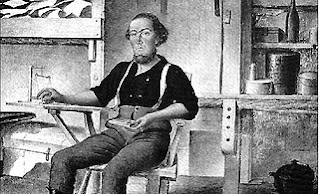The Earth Lodge People: the Mandan
When early explorers encountered Native people and wanted to designate them in a written record, they often went with what the surrounding tribes called them, rather than the tribe's own name for themselves. The Mandan are a Siouan-speaking people living in North Dakota with two closely allied tribes, the Hidatsa and Arikara. Historically, their range was the Missouri River, in what is now North and South Dakota. They were living there when French explorers encountered them in 1738. The French adopted the name Mandan as a corruption of various Siouan words for people who dwelt in earth lodges or people who lived under ground. Later Anglo explorers stated that the Mandans referred to themselves as People of the Pheasants. Most likely, like many Native tribes, they had a variety of names that referred to themselves as people.
Mandan oral history reveals that their original home was near a large lake. Like other Siouan peoples, pre-Contact Mandan likely lived in the Ohio and Mississippi River Valleys, later following the Missouri River to their location in North and South Dakota. They built nine villages along the Missouri River and led a stationary existence, depending on agriculture in contrast to the nomadic hunting and gathering people around them. Jesuit priest Jean-Pierre Aulneau first mentioned the Mandans in a 1736 letter. He was planning to go to visit them before he was killed elsewhere. Sieur de la Vendrye visited the Mandan in 1738 and gave extensive descriptions of their society. By that time, they had acquired horses from the Apache. The Mandan served as middlemen and traders for the French and other tribes around them, such items as horses, dogs, foodstuffs and buffalo items. The Spanish also sought them out for trading, as did later English and Americans.
In 1796, a British explorer John Evans visited the Mandan, trying to track down a myth that their language contained Welsh words. He later wrote to authorities back home, squelching the story entirely. By the time Lewis and Clark visited the Mandan, their numbers had been reduced by disease and warfare with the Lakota and Dakota. The Mandan later formed a defense alliance with the Arikara to combat this threat. The Lewis and Clark Expedition spent the winter with the Mandans, building a fort, which they named Fort Mandan. It was there that they encountered a Shoshone woman, Sacajawea, who would prove invaluable to their expedition. On their return trip, the explorers invited a Mandan leader to go with them to meet President Jefferson. In 1825, Mandan leaders signed a treaty with members of the Atkinson-O'Fallon Expedition. They were one of the few tribes who never met American troops in open warfare.
The Mandan endured warfare with other tribes, particularly the Sioux, and more smallpox epidemics that further decreased their numbers. In 1851, they signed a treaty along with the Hidatsa and Arikara, which called for protection from the Sioux by United States troops. Difficulties with the Sioux continued throughout much of the 19th century. Pursuant to the Indian Reorganization Act of 1934, they affiliated with the Arikara and Hidatsa Tribes, an alliance which still persists today.
Mandan oral history reveals that their original home was near a large lake. Like other Siouan peoples, pre-Contact Mandan likely lived in the Ohio and Mississippi River Valleys, later following the Missouri River to their location in North and South Dakota. They built nine villages along the Missouri River and led a stationary existence, depending on agriculture in contrast to the nomadic hunting and gathering people around them. Jesuit priest Jean-Pierre Aulneau first mentioned the Mandans in a 1736 letter. He was planning to go to visit them before he was killed elsewhere. Sieur de la Vendrye visited the Mandan in 1738 and gave extensive descriptions of their society. By that time, they had acquired horses from the Apache. The Mandan served as middlemen and traders for the French and other tribes around them, such items as horses, dogs, foodstuffs and buffalo items. The Spanish also sought them out for trading, as did later English and Americans.
In 1796, a British explorer John Evans visited the Mandan, trying to track down a myth that their language contained Welsh words. He later wrote to authorities back home, squelching the story entirely. By the time Lewis and Clark visited the Mandan, their numbers had been reduced by disease and warfare with the Lakota and Dakota. The Mandan later formed a defense alliance with the Arikara to combat this threat. The Lewis and Clark Expedition spent the winter with the Mandans, building a fort, which they named Fort Mandan. It was there that they encountered a Shoshone woman, Sacajawea, who would prove invaluable to their expedition. On their return trip, the explorers invited a Mandan leader to go with them to meet President Jefferson. In 1825, Mandan leaders signed a treaty with members of the Atkinson-O'Fallon Expedition. They were one of the few tribes who never met American troops in open warfare.
The Mandan endured warfare with other tribes, particularly the Sioux, and more smallpox epidemics that further decreased their numbers. In 1851, they signed a treaty along with the Hidatsa and Arikara, which called for protection from the Sioux by United States troops. Difficulties with the Sioux continued throughout much of the 19th century. Pursuant to the Indian Reorganization Act of 1934, they affiliated with the Arikara and Hidatsa Tribes, an alliance which still persists today.




Comments
Post a Comment